Pioneer XDJ-RX
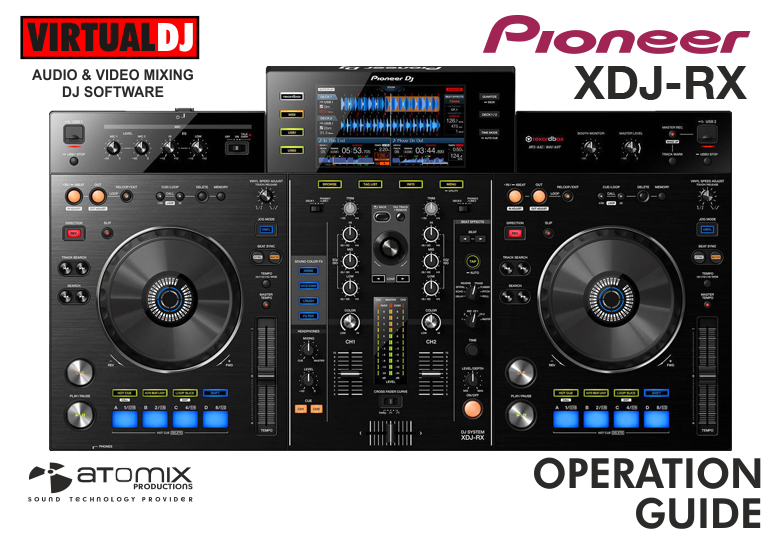
INSTALLATION
Firmware & Drivers
Firmware: Update the firmware of the unit to the latest version from https://www.pioneerdj.com/en/product/all-in-one-system/archive/xdj-rx/black/support/
Attention: This unit will not operate with VirtualDJ if firmware is not version 2.20 or later!
Drivers: Install the latest drivers (for both Windows and Mac OSX computers) from https://www.pioneerdj.com/en/product/all-in-one-system/archive/xdj-rx/black/support/
VirtualDJ 8 Setup
Once VirtualDJ 8 is launched, a Login Window will appear. Login with your virtualdj.com account.
A Pro Infinity or a Pro Subscription License is required to fully use the Pioneer XDJ-RX. Without any of the above Licenses, the controller will operate for 10 minutes each time you restart VirtualDJ.
http://www.virtualdj.com/buy/index.html

Click on the "Use Soundcard" button in order VirtualDJ to apply the pre-defined audio configuration.
Click to OK.

The unit is now ready to operate.
MIDI Operation
Find more details at
http://www.virtualdj.com/wiki/VDJ8script.html
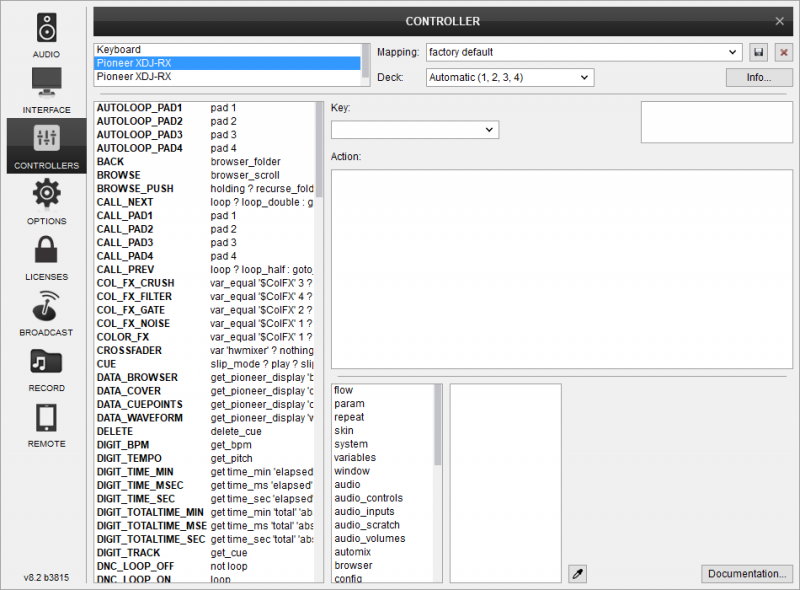
AUDIO Setup
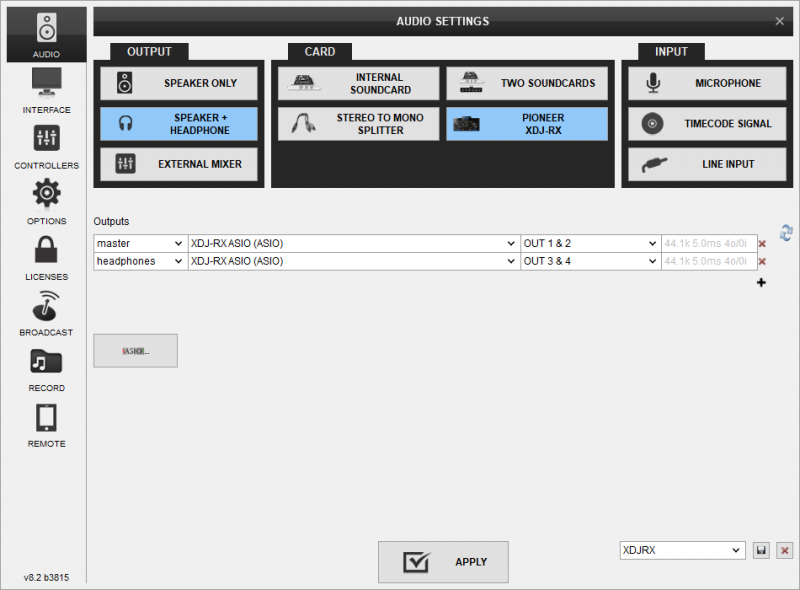
For further software settings please refer to the User Guide of VirtualDJ 8.
http://www.virtualdj.com/manuals/virtualdj8/index.html
LAYOUT
S SHIFT: Hold this button down to access secondary functions of Pioneer XDJ-RX

The functionality of each button, knob and slider per section (as shown in the image above) will be explained in detail in the next chapters
Mixer
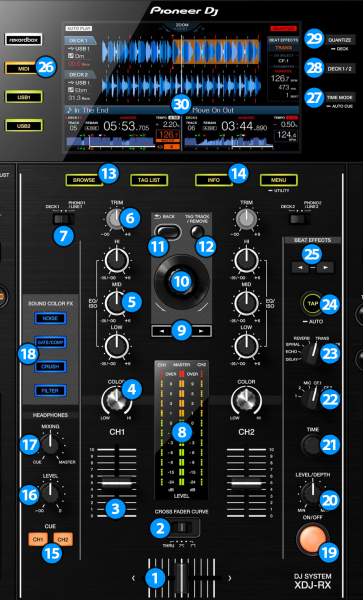
- CROSSFADER. Blends audio between the channels assigned to the left and right side of the crossfader.
- CROSSFADER CURVE ADJUST. Adjusts the curve of the crossfader.
- VOLUME. Adjust the Volume of each channel.
- COLOR FX PARAMETER. Adjust the parameter of the selected COLOR FX for each channel. When in middle position, the COLOR FX has no effect on the sound.
- HIGH/MID/LOW (EQ). Adjust the High, Mid and Low frequencies for each mixer channel.
- TRIM. Adjust the Gain of each mixer channel. Note that the "zero gain / park" position is 12 o clock.
- INPUT SELECTORS. Define the source of each Channel. Put the switchers to DECK1 or DECK2 position for software mixing.
- CH INPUT & MASTER VUMETERS. Shows each channel's input (pre fader) volume on each side. Shows master output volume on center (hardware operation)
- LOAD. Loads the currently selected track on the deck.
- BROWSE.
Turn: Scrolls through files or folders.
Push: If the focus is on Folders list, it switches focus on Songs list. If focus is on Songs list it loads the selected track on the first free deck. - BACK. Sets focus to the Folders list. If focus is on the Folders list, it opens and closes subfolders.
- TAG TRACK. Opens the Tag Editor window to enter/edit information for the selected track on the browser.
- BROWSE. Press this button in order to see the Songs list on the screen of XDJ-RX and browse for tracks.
- INFO. Press this button to see more information about the loaded tracks on each deck.
- CUE (PFL) (per channel) Press these buttons to send each channel to the Headphones Output channel.
- HEADPHONES VOLUME. Adjust the volume of the Headphones Channel.
- HEADPHONES MIXING. Adjust how the Channels and the Master Output blend at the Headphones Channel. Hardware operation, but movement visible on the VirtualDJ GUI.
- SOUND COLOR FX. Select one of the Color Effects to be applied on each deck when using the "Color FX Parameter" knob (4). Please note that not all Color FX are supported.
- FX ON/OFF. Activate/Deactivate the selected effect on the selected channel.
- FX DEPTH. Adjust the first parameter of the selected effect on the selected channel.
- FX TIME. Adjust the second parameter of the selected effect on the selected channel.
- FX CH SELECT. Select at which channel the selected effect will be applied.
- FX SELECT. Select an effect to be applied on the selected channel. Please note that not all effects are supported.
- TAP. Tap this button a few times in order to calculate a new BPM for the selected channel.
- BEAT. Adjust the length (in beats) of the selected effect on the selected channel (only for effects that support this function)
- MIDI. Prepares XDJ-RX for communication with PC software. Press this button once and then press the LOAD buttons (9) in order to set each deck in PC communication mode.
- TIME MODE. Press this button to cycle the display between Elapsed and Remain time modes.
- DECK 1/2. Press this button to access the second layer of deck of XDJ-RX (decks 3 & 4)
- QUANTIZE. Press this button to toggle Quantize on/off. When Quantize is enabled, setting loops, jumping between hot cue points and starting playback of the deck will snap to the grid (CBG) of the track
- DISPLAY. Displays information about the browser and the loaded tracks.
Deck Controls
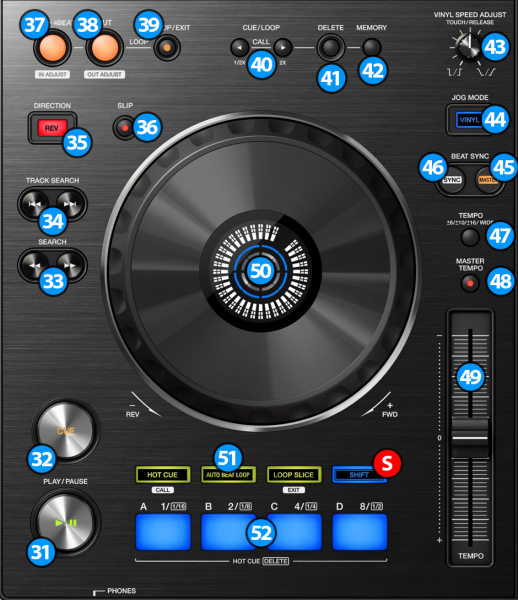
- S SHIFT. Press and hold this button to access secondary functions of XDJ-RX
- PLAY/PAUSE. Plays / Pauses the track. Press and hold SHIFT and then press this button to "stutter-play" the track from the last set Cue Point.
- CUE. When the Deck is paused, you can set a temporary Cue Point by moving the Platter to place the Audio Pointer at the desired location and then pressing the Cue Button. During playback, you can press the Cue Button to return the track to this Cue Point. (If you did not set a Cue Point, then it will return to the beginning of the track.). If the Deck is paused, you can press and hold the Cue Button to play the track from the Temporary Cue Point. Releasing the Cue Button will return the track to the temporary Cue Point and pause it. To continue playback without returning to the Temporary Cue Point, press and hold the Cue Button, then press and hold the Play Button, and then release both buttons.
Hold down SHIFT and then press this button to return to the beginning of the track. - SEARCH. Change position of playback inside the track and keep it beat synced.
- TRACK SEARCH. Load the next song of the current list on the deck. Please note that this function is available only when a deck is not audible on air.
- DIRECTION. Press this button to play the track backwards. Press again to return to forward direction. Hold down SHIFT and hold this button to play the track backwards. On release the track will continue from the position it would have been if the button was never pressed.
- SLIP. Enables Slip Mode. Several software functions (such as Jogwheel movements, HotCues and Loops) will apply temporary on the track, and the track will return to the position it would have been if those functions were not triggered.
- LOOP IN. Press this button to set a Loop In point (for manual looping). While a Loop is active press this button once again and use the JOG (50) in order to fine-tune the Loop In point (In Adjust). The led of the button will blink fast to notify you for that. Press this button once again to return to normal operation.
- LOOP OUT. Press this button to set a Loop Out point (for manual looping). The loop will start playing immediately. While a Loop is active press this button once again and use the JOG (50) in order to fine-tune the Loop Out point (Out Adjust). The led of the button will blink fast to notify you for that. Press this button once again to return to normal operation.
- RELOOP/EXIT. If a Loop is active, press this button to exit the Loop and continue normal playback. If a Loop is not active press this button to reactive the last used loop.
- CUE/LOOP CALL. Press these buttons to select one of the set hot cues of the track. While a Loop is active press these buttons to halve/double the size of the Loop.
- DELETE. Press this button to delete the currently selected hot cue.
- MEMORY. Press this button to set the current position as a temporary cue point that will be used by the CUE (32) button.
- VINYL SPEED ADJUST. Adjust the time needed for the track to reach to full stop when PLAY/PAUSE (31) button is used to stop the deck, or when you touch the JOG (50) while in Vinyl Mode (vinyl brake).
- JOG MODE. Press this button to toggle between the Scratch and Bend Jogwheel modes.
- MASTER. Press this button to set this deck as Master Deck (for 4 decks skins).
- SYNC. Press this button to automatically match the corresponding Deck's tempo with the opposite Deck's (or the Master Deck’s if using a 4 decks Skin) tempo and phase.
- TEMPO RANGE. Press this button to change the range used by the TEMPO (49) fader between 6%,10%,16% and 100%
- MASTER TEMPO. Press this button to "lock" the track's pitch to its original key. The track's tempo will remain at the speed designated by the TEMPO (49) fader.
- TEMPO. Controls the track's playback tempo. If the tempo position of the unit and the actual tempo of the software do not match the tempo slider of the XDJ-RX will not control the tempo of the deck until it meets the software value (soft take-over).
- JOGWHEEL. Touch sensitive platter for scratching (vinyl mode) or bending (CD Mode)
The outer white leds will rotate according to the software jogwheel position.
The inner blue ring will turn on when the deck is audible on air. - PAD MODE. Switch the pads of the unit to various modes (see PADS)
- PADS. Offer various operations, depending on the PADs Mode (see PADS)
PADS
The 4 Pads offer various functions, depending on the selected Pad mode. Each of the 3 Pad Mode buttons offers 2 individual modes (hold SHIFT and then press the PAD MODE button to access the additional mode).
The modes represent a page of the PADS section on the default VirtualDJ GUI.
HotCues Mode
Each one of the 4 pad assigns a Hot Cue Point (1 to 4) or returns the track to that Hot Cue Point. When a Hot Cue Button is unlit, you can assign a Hot Cue Point by pressing it at the desired point in your track.
Hold SHIFT and then press a pad to delete its assigned Hot Cue Point.
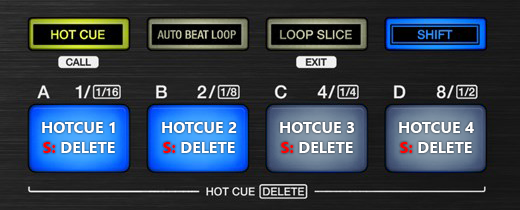
Auto Loop Mode
Each one of the 4 pad triggers a seamless Loop of a different size (in beats).
Hold SHIFT and then press the same Pads to trigger a different loop size (see image)
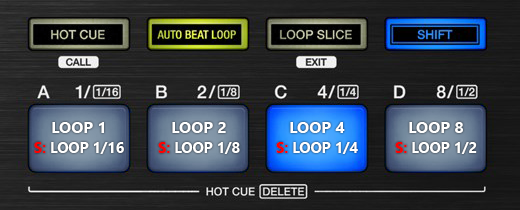
Slicer Mode
The 8 pads (4 in normal operation and 4 while SHIFT button is held down) represent eight sequential beats—"Slices"— in the Beat Grid. The currently playing Slice is represented by the currently lit pad. The light will move through the pads as it progresses through each eight-slice phrase. Press a pad to repeat that Slice (hold it down if you want to keep looping it).
Once the Pad is released the track will continue to play from the position it would have been if the pad was never pressed.
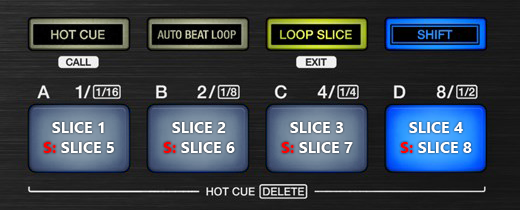
Saved Loops Mode
Each one of the 4 pad represents a slot to save and recall a loop.
Press a Pad to save (and trigger at the same time - if not already) a Loop at the current position.
Hold the same Pad down for more than 2 seconds to delete the saved loop from the slot.
When a Loop is saved to a slot, use the same Pad to load* (enable) the saved loop, but not jump to its position if the loop is saved to a later position than the current one (loop load and prepare).
Hold SHIFT and then use the same Pad to load* (enable) the saved loop, and jump to its position.
*Note that only 1 Loop can be enabled each time.

Manual Loop Mode
Use the 1st PAD to set a Loop In (Entry) point. Use the 2nd PAD to set the Exit point of the loop (Loop Out). Use the 3rd PAD to exit the Loop (if a loop is active) or to create an automatic Loop. Use the 4th PAD to activate the last triggered loop (Reloop)
Hold SHIFT and use the 1st and 2nd PADs to halve or double the size of the loop.
Hold SHIFT and use the 3rd and 4th PADs to move the triggered loop 1 beat backwards or forward.
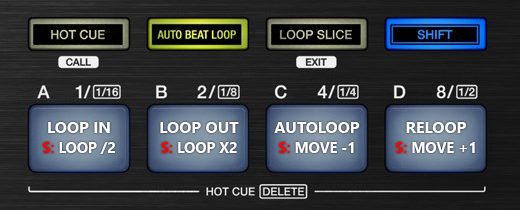
Beat Jump Mode
In this mode, the 4 PADs will jump the track backwards/forward by the amount of beats depending on the selected Beatjump page (from 1/8 beats to 32 Bars)
Hold SHIFT and use the PADs to jump on different sizes of beats.
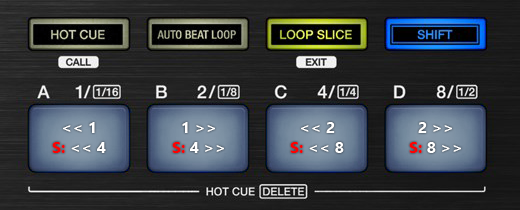
Master & Mic

- MIC VOLUME. Adjust the Volume Level of MIC1 and MIC2 Inputs of XDJ-RX (Hardware operation)
- MIC EQ. Adjust the HIGH and LOW frequencies of MIC1 and MIC2 Inputs of the XDJ-RX (Hardware operation)
- MIC CONTROL. Turn ON and OFF the MIC1 and MIC2 Inputs of the XDJ-RX or enable the auto Talk Over. (Hardware operation)
- BOOTH MONITOR. Adjust the level of the Booth Output of the XDJ-RX . Hardware operation, not visible on the VirtualDJ GUI.
- MASTER VOLUME. Adjust the level of the Master Output of the XDJ-RX. Hardware operation but movement visible on the VirtualDJ GUI